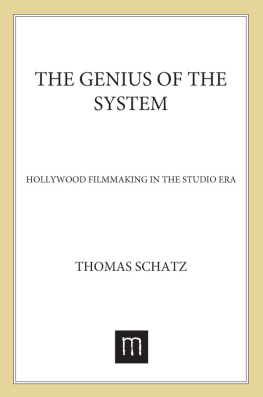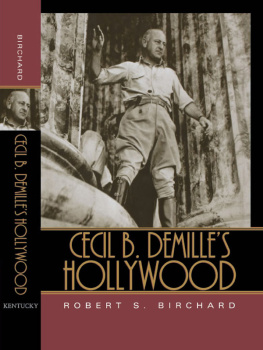
Vintage Books Edition, December 1994
Copyright 1975, 1994 by Robert Sklar
All rights reserved under International and Pan-American Copyright Conventions. Published in the United States by Vintage Books, a division of Random House, Inc., New York, and simultaneously in Canada by Random House of Canada Limited, Toronto. Originally published by Random House, Inc., in 1975 in somewhat different form.
Library of Congress Cataloging in Publication Data
Sklar, Robert.
Movie-Made America.
Bibliography: p.
1. Moving-picturesUnited StatesHistory. I. Title.
[PN1993.5.U6S53 1976] 791.430973 76.8945
eISBN: 978-0-307-75684-8
v3.1
FOR LEONARD AND SUSAN
CONTENTS
PREFACE
TO THE UPDATED EDITION
Since this book first appeared in 1975, a virtual revolution has occurred in knowledge of American movie history. Studio archives and personal papers of filmmakers have become available for research. Films hitherto inaccessible are screened on television and sold or rented as videocassettes. And nearly as many books and articles on American film are published in a single year as in the entire first three quarters of the twentieth century.
Nevertheless, the perspectives offered by Movie-Made America have managed to maintain their relevance. Questions the book raised about communications media, cultural power and dominant ideology retain their cogency, while answers confidently propounded in subsequent years have not long sufficed. Are the conflicts over ethnicity, religion and class that shaped the movies relations to a wider American culture now obsolete? Will struggles around race and gender replace them? As movies celebrate their centennial and take their place in the twenty-first century entertainment and information nexus, these are among the issues Movie-Made America may help to elucidate.
Historical studies are products of an authors relationship to a present time and place, as well as to the past. Though my own further research and film viewing and the scholarship of others have reshaped my views on several subjects, I have respected the setting and motive of the books first publication by keeping the original text largely intact, except for correcting errors. Chapters 19 through 22 and a bibliography have been added for this edition.
I particularly thank Frances Collin for her encouragement and perseverance that have carried this revised edition to completion. At Random House and Vintage Books, Anne Freedgoods astute attention to stylistic detail helped to give the original text a vitality that has aided its survival; Miranda Sherwin provided impetus for a new edition and Jenna Laslocky saw it through with a steady and supportive hand. Giorgio Bertellini assisted in compiling the updated bibliography. Mary Corliss and Terry Geesken of The Museum of Modern Art/Film Stills Archive aided in acquiring illustrations.
I am grateful for the support of my colleagues and students in the Department of Cinema Studies, Tisch School of the Arts, New York University, and for the assistance of Ann Harris and Cathy Holter and their staffs at the departments George Amberg Film Study Center. Leonard Sklar and Susan Sklar Friedman, to whom this book is dedicated, have gone on to make their own contributions, respectively, in the fields of water resources and film editing. They, along with Kate Tentler and Justin Tentler, continue to provide inspiration. As always, Adrienne Harris helped me in innumerable ways.
May 1994
R.S.
PREFACE
This book, as is often the case, is not the book I intended to write when I began it. In the late 1960s I had reached a point in my work as a historian and critic of twentieth-century American culture when I felt the need to explore the role of movies as an art form, and as an influence on other arts. As I immersed myself in the subject, however, I soon began to see that the approach I was taking would not lead me to the heart of the matter. Its conception of both movies and culture was too narrow. One had to go beyond the handful of major directors and the few dozen classic films, and even beyond the great inchoate mass of movies as a whole, to try to understand motion pictures in their largest sense, as a mass medium of cultural communication.
In the process of expanding my approach to movies I also began to redefine my ideas of culture, shifting my focus from artists and their creations to people and their lives. From this perspective, the advent of movies on the American cultural scene at the beginning of the twentieth century clearly posed a challenge to existing cultural policies and institutions, and to elucidate the story of that challenge and the responses to it became a primary purpose of this book.
That task has led me to examine, among other topics, the invention of motion-picture technology; the nature and evolution of the motion-picture audience; the organization and business tactics of the movie trade; the design and economics of theaters; the social and professional lives of movie workers; government policies toward movies, and the attitudes and strategies of censorship groups; and the cultural influence of movies at home and overseas.
In my research I sought to explore the cultural aspects of American movies as broadly as possible through published and unpublished materials (these sources are detailed in the Notes on Sources; only direct quotations are cited in the text). I have also screened hundreds of films from all periods and have triedwith only a few exceptionsto refer in the book solely to movies I have seen or re-seen since I began this work half a dozen years ago.
I am acutely aware that subjects to which I devote a paragraph or a page could with justice receive far more extensive treatment; and other topics of considerable interest (for example, the influence of movie set and clothing designers on consumer tastes) I was unable to find room for at all. There are a number of important directors whom I greatly admire, in particular John Ford, Josef von Sternberg and Orson Welles, to whom I should have liked to give far more attention.
The lack of cultural studies, however, persuaded me of the value of writing a single volume covering the cultural history of American movies from the 1890s to the present, to provide a broad framework for understanding their significance. It is important to begin with a recognition that movies have historically been and still remain vital components in the network of cultural communication, and the nature of their content and control helps to shape the character and direction of American culture as a whole.
My understanding of the structure and transformations of American culture in the twentieth century is still far from complete. At various times I have found myself obliged to use such terms as dominant order or dominant ideology without fully explaining what groups and concepts in the culture these phrases represent. One of the tasks of cultural historians is to elucidate the nature of cultural power in the modern United States, and more important, its connections with economic, social and political power. I hope this book makes a contribution to that subject, at least to illuminate its complexity, its imperviousness to simple answers.
In the case of movies, the ability to exercise cultural power was shaped not only by the possession of economic, social or political power but also by such factors as national origin or religious affiliation, not to speak of far more elusive elements, such as celebrity or personal magnetism. The movies were the first medium of entertainment and cultural information to be controlled by men who did not share the ethnic or religious backgrounds of the traditional cultural elites: that fact has dominated their entire history, engaging them in struggles on many fronts, and sometimes negating the apparent advantage enjoyed by men who otherwise adhered faithfully to the proper capitalist values and conservative political beliefs.










